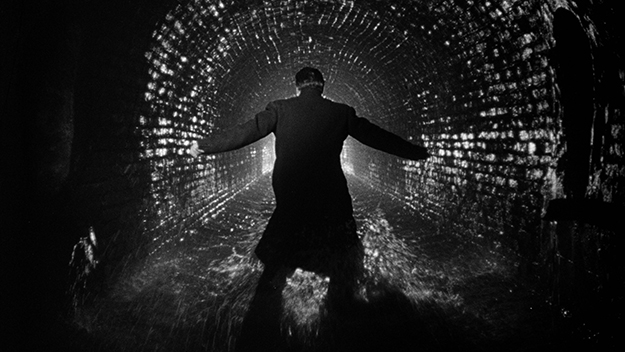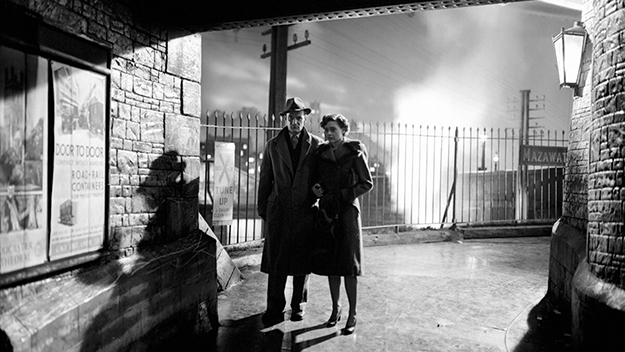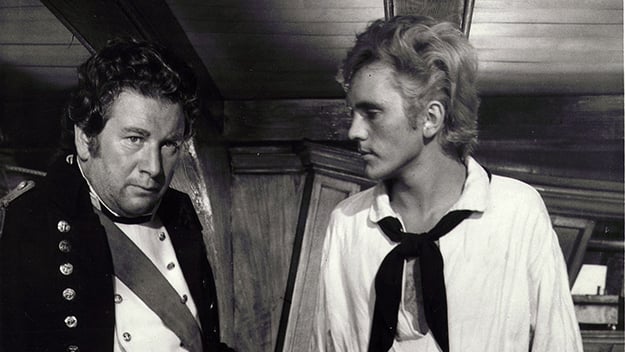TCM Diary: Robert Krasker, Master of Light

The Third Man (Carol Reed, 1949)
Robert Krasker collected a no-contest Academy Award for photographing Carol Reed’s The Third Man and was worshipped by his collaborators (including actors: Terence Stamp called him the “J.M.W. Turner of light”). But collaborating with directorial heavyweights like Carol Reed, David Lean, Luchino Visconti, William Wyler, and Anthony Mann has arguably consigned his name to the fine print of film history. Brief Encounter, The Third Man, and Billy Budd—a trio of black-and-white films playing on TCM this month and all lensed by Krasker—offer a reminder of this great mid-20th-century craftsman’s indelible contribution to the films he photographed and to the evolving commercial art form he helped refine.
A formative interest in fine art and in cameras lured Robert Krasker from his home in Australia to Paris and then Weimar Berlin. There, psychologically determined, shadow-drenched deep focus film photography was the rule, not the exception, and visually unadorned photographic realism in cinema was an almost avant-garde parallel creative preoccupation. The flex between the heightened and the naturally captured image would energize his subsequent work in film. Krasker’s British apprenticeship with Alexander Korda’s secret weapon, Georges Périnal (a veteran of Vigo), provided a paid master class in the French cinematographer’s genius for using differing densities and details of light and shadow to inexpensively add visual agency to Korda’s early low-budget historical portraits of Henry the VIII and Rembrandt van Rijn.
Krasker’s fifth credited film as “lighting cameraman” (that’s British for “cinematographer”) was 1945’s Brief Encounter, depicting a borderland where expressionistic psychological interiority meets the quotidian details of middle-class existence. Noel Coward’s script sets the film before World War II, and the romantic recollections of the married Laura Jesson (Celia Johnson) serve as a gateway to an unspoken yearning for what was, to war-weary contemporary British audiences, a vanished suburban England of comparative ease and innocence. Co-lead Trevor Howard was reportedly so confused by his character’s credulity-straining old-school chivalry toward Laura that he demanded of director David Lean: “Why doesn’t he fuck her?”

Brief Encounter (David Lean, 1945)
An evolving exchange between Laura and a heedless gossiping acquaintance seated opposite her on a commuter train contains one of my favorite light tricks in movies. Krasker frames Johnson’s expertly doleful distraction (somehow even her teeth seem sad) in a slightly down angle close-up favoring both her forehead and her eyes. The train leaves the station and Krasker subtly veils Laura’s motor-mouthed companion in a net of shadow from a largely unseen window curtain before the camera returns to Johnson. Then, Laura’s voice fades up and Krasker’s background light fades down, turning the tatty upholstery pattern behind Johnson’s head into a blacked-out abyss. “Nothing lasts, really, neither happiness nor despair,” Laura tells herself in voice over, and, finally: “I want to remember this to the end of my days.” The moment over, the train pulls into the station and the original background light and texture return. Did the shadow over Laura’s reverie come from a tunnel, or a waking dream? Whatever the source, the two women swiftly exit the train. Moments later a crossfade consigns the cannily unbalanced lighting sequence and its lovely oddball theatricality to audience memory.
Vanished pre-war innocence also drive The Third Man. The film’s celebrated canted angles and Germanic low-key-lit foot chases visually shatter a city—whose bygone waltz and leisure culture was in the words of film historian Steven C. Smith “enamored of all things rotational”—into jagged, graceless, unmoving pieces. Repeat viewings of The Third Man yield visual pleasures derived from Krasker ingeniously performing a black-and-white photographer’s fundamental due diligence: separating the filmed subject from the filmed background. An early scene pitting Joseph Cotten’s naïvely loyal Holly Martins against Trevor Howard’s efficiently implacable military cop Calloway plays as much on Calloway’s perfectly timed, carefully lit plumes of cigarette smoke lassoing Martins’s face, as it does on dialogue.
When Harry Lime’s lover, Anna, and Martins confront Calloway during a surprise police search of Anna’s flat, the principals move through a ransacked room crowded with military police and, eventually, Anna’s landlady. A mobile camera tracks around and over the bed Anna and Harry once shared. Callaway and his deputy’s examination of Anna’s forged papers plays largely in deep focus two shots intercut with disinterested multinational soldiers clumsily manhandling Anna’s cache of Harry’s love letters elsewhere in the room. Anna’s anxious double confession of both her forged citizenship and her un-diminished passion for Lime is largely shown in gently lit shallow focus singles that hold actress Alida Valli alone in medium and tight closeup. Holly Martins’ inability to emotionally digest Anna’s yearning for a dead man and his own ebbing loyalty to Harry’s memory (little does he know…) drives him into a low ceiling kitchenette complete with a curtain, where Krasker’s ingenious lighting scheme recasts a grubby alcove as a sort of stage-within-a-set proscenium.

Peter Ustinov and Terence Stamp in Billy Budd (Peter Ustinov, 1962)
Krasker and director Peter Ustinov opted to film 1962’s Billy Budd in black-and-white widescreen. According to Stamp, playing the title role in his film debut, it was Krasker’s idea to dye Stamp’s hair blonde to set the angelic Budd apart from the rest of HMS Avenger’s crew and to clearly seat him in intricately composed ’scope frames teeming with foreground rigging and background shadows. Krasker took such pains to light the film’s shipboard day exteriors without relinquishing visual control to the southern Spanish location that Stamp recalls the DP instructing him on how not to go blind from gazing into the brute arc lamps on hand to outshine the Iberian sun.
In one nighttime scene on deck, Budd interrupts a fellow crew member as he attempts revenge on sadistic master-at-arms John Claggart (Robert Ryan). Krasker’s photography supports and explicates the rising drama while accurately simulating practical nighttime light sources appropriate to the film’s pre-electric period. Budd’s confrontation with the would-be assassin climaxes over a deck grating that had been removed and used as a makeshift pillory for the offended sailor’s flogging in a previous daytime scene. Now, at night, the grating’s holes provide an unearthly uniform upward light source from flickering lamps below decks. Budd’s fight with the man and Claggart’s interruption and exploitation of the two sailors’ rule-breaking take place between a pointillist glow from underneath and ominous blanketing moonlight coming from above. It is, in a word, beautiful.
Ill health forced Robert Krasker into premature retirement in the late ’60s. He died in 1981 without enjoying the kind of late-career victory lap U.K. camera contemporaries Gilbert Taylor, Oswald Morris, and Douglas Slocombe each took when hired by George Lucas, Sidney Lumet, and Steven Spielberg respectively near the ends of their careers. Yet Krasker’s handful of films speak for themselves. “Virtually everything he did,” Brian McFarlane observes in his fittingly understated assessment in The Encyclopedia of British Film, “was notable.”
The Third Man plays on TCM on February 15 at 4 p.m. EST.
Brief Encounter plays on TCM on February 18 at 8 p.m. EST.
Billy Budd played on TCM on February 1 and is available to stream on Youtube and elsewhere.
Bruce Bennett is a TV writer and producer and recovering film critic based in Woodside, NY.







